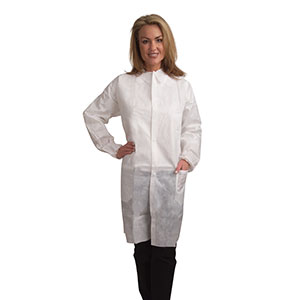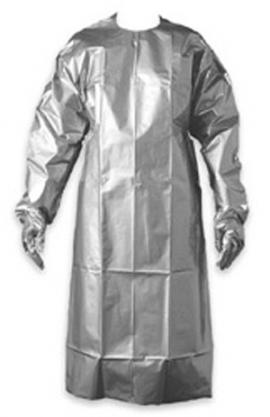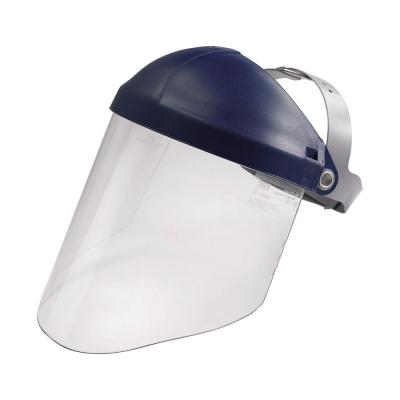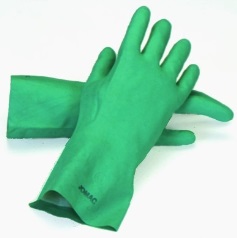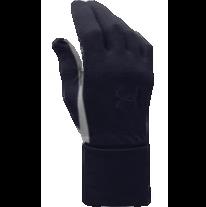Personal Protective Equipment (PPE) is a temporary defense barrier against exposure to hazardous material. It is important to understand its limitations and how PPE works. The Personal Protective Equipment Program was created to outline the requirements for selecting appropriate PPE and how to document the selection.
Hand Protection
When working in a laboratory, the hands are most likely to come into contact with hazardous material and should always be protected. Gloves are available in various materials, thicknesses, and with different cuff lengths for protection against different hazards. Always inspect gloves for holes and signs of degradation before beginning work with hazardous materials. Take care not to contaminate objects in the laboratory that are usually touched without gloves, e.g., phones, pens, computers, or faucets. Gloves should be removed before touching such objects. For the same reason, gloves should be removed when leaving the laboratory. They should not be worn in the corridors, elevators, or when touching door handles and buttons.
Glove Selection
Glove material and thickness determine how resistant the glove is to a certain chemical. Manufacturers test their gloves for protection against common chemicals and often provide glove selection charts summarizing the results of tested parameters:
Breakthrough Time
The time it takes for a chemical to travel through the glove material until it can be detected on the inside.
Degradation Rating
The physical change that happens to the glove when it is exposed to a chemical. This may include cracking, swelling, hardening, or shrinking.
Permeation Rate
The rate at which a chemical is absorbed by the glove, travels through the glove, and is emitted by the glove on the inside.
If a glove material has a high resistance to one chemical, it does not mean that it is resistant to all chemicals. Always check the manufacturer’s rating when selecting a glove to work with a particular hazardous material.
Disposable Gloves
The commonly used thin disposable gloves provide very limited protection against chemicals. Nitrile often provides slightly more protection than latex but most chemicals will penetrate the material within a few seconds. Because many people are allergic to latex, an alternative to latex (e.g., nitrile) should always be provided. Disposable gloves can be used for powders and liquids of low toxicity in situations where incidental splashes may occur. They provide good protection against biological material. Should the glove become contaminated, remove it immediately and wash the hands. Disposable gloves have no mechanical resistance, should be changed frequently, and should NEVER be reused.
Reusable Gloves
Reusable gloves are thicker and more chemically resistant than disposable gloves. They often have a longer cuff to protect the wrist and lower arm. They can be used multiple times when properly cleaned and maintained after each use. Butyl rubber, nitrile, neoprene, and Viton® are the most commonly used materials. No material is acceptable for all chemicals.
Consult manufacturer glove selection charts when selecting a glove for a certain chemical.
Silver Shield®/4H® gloves are made of a laminated polymer; a thin, light-weight material that provides excellent resistance against many chemicals, but not all. These gloves can be worn underneath a mechanically resistant glove when chemical and puncture resistance are required. Wearing a disposable glove over a Silver Shield glove improves the user’s dexterity.
Chemically resistant gloves should be used when handling chemicals that are highly toxic by skin contact, for handling large amounts of corrosive liquids, and for any procedure where chemical contact is expected, e.g., when immersing hands in a chemical.
Fire-Retardant Gloves
Fire-retardant gloves can be worn underneath disposable gloves to provide protection when working with pyrophorics.
Thermal Gloves
Cryogenic gloves protect from the extreme cold of cryogenic liquids. They must fit loosely so that they can be removed quickly should a splash occur. Cryogenic gloves are NOT heat resistant and the material may melt when touching hot objects. Heat-resistant gloves should be used for handling hot objects.
Cut-Resistant Gloves
Cut-resistant gloves are recommended for working with blades, broken glass, or stuck glass joints.
Leather Gloves
Leather gloves are recommended for mechanical work, e.g., moving gas cylinders, or when handling glass. They do NOT provide protection against chemicals.
Eye and Face Protection
The eyes are particularly sensitive to most chemicals and allow infectious agents to enter the body. It is important to always protect the eyes from incidental splashes and impacts when working in a laboratory. Prescription glasses do NOT provide adequate protection against splashes or impact. Eye protection that fits over prescription glasses and prescription safety glasses are available. All eye protection should be ANSI Z87.1-2010 certified.
Safety Glasses
Safety glasses with side shields provide minimum protection against incidental splashes. People in the laboratory should always wear them even if they are not actively working.
Goggles
Goggles provide a higher level of protection than safety glasses. They should be used when handling highly corrosive chemicals that can permanently damage the eye. Three different types of goggles are available:
- Unvented goggles protect from irritating and corrosive vapors and splashes;
- Goggles with indirect vents protect against splashes but not against vapor;
- Vented goggles provide impact resistance only and should not be used when handling chemicals.
Face Shields
A face shield protects the face against splashes and impacts. It should be worn in conjunction with splash goggles when handling chemicals that are highly corrosive and/or toxic when in contact with skin, in particular when large volumes of liquid are used that make splashes likely. It should also be used when performing potentially explosive experiments.
Face shields come in different materials that vary in their resistance to chemicals and impact. They should be at least ANSI 87.1 certified.
For protection against aerosols and splashes of biological material, disposable face shields are also available.
Body Protection
Clothing
Appropriate clothing provides basic protection against skin exposure. Footwear that completely covers the feet and clothing that covers the legs should always be worn in a laboratory. Loose clothing and long hair should be confined.
Laboratory coats
Laboratory coats provide additional protection and keep hazardous materials off the clothes so it does not get transferred into areas outside the laboratory. They should be removed quickly if a splash occurs. Lab coats require a special laundry service and should not be taken home for washing. Check with your department about laundry services.
Disposable lab coats can provide an alternative if the coat material is suitable for the hazards involved (see below).
Laboratory coats are available in different materials and different styles. Preferable styles include tight cuffs to prevent accidents and snap closures on the front so that the coat can be removed quickly should a splash occur. The preferable coat material depends on the hazard:
Polyester/cotton blends provide good protection against aqueous splashes but most chemicals will quickly penetrate the material. Because of the synthetic material content, polyester/cotton blends are not flame resistant and will quickly melt to the body if ignited.
100% cotton lab coats are not flame resistant but burn less readily than the polyester/cotton blends and the material will not melt. They are not splash resistant and they absorb fluids quickly.
Flame-resistant lab coats are blue. They are made either from flame resistant fibers or from cotton that was treated with a flame retardant. Resistance to chemicals is not always known and depends on the manufacturer. Flame-resistant lab coats cannot be washed with bleach. They require a special laundry treatment to maintain the flame resistance. Flame-resistant lab coats should be worn when handling large amounts of flammables and whenever handling pyrophoric material.
Microbreathe and similar lab coats made from synthetic material provide good protection against aqueous splashes and body fluids. Resistance to chemicals is limited. They are commonly worn in biology and clinical labs. They are not flame resistant and should not be used when handling flammable material.
Aprons and Smocks
Chemically resistant aprons and smocks provide better protection against chemical splashes than lab coats. They should be worn for chemicals with a high dermal toxicity (e.g., hydrofluoric acid), when handling large amounts of corrosive chemicals, or when splashes are likely to occur.
Respirators
The University's Respiratory Protection Program is overseen by the Division of Safety and Compliance, Occupational Safety and Health Department. The program is intended ot protect the health of faculty, staff and students when effective engineering or administrative controls are not feasible or practical, or in emergency situations; and to promote compliance with state occupational safety and health standards.
A respirator is used to prevent the wearer from inhaling dangerous airborne contaminants. Respirators protect the user in two basic ways. The first is by removing contaminants from the air through filtration, absorption/adsorption or reaction/neutralization. The second way respirators may protect the user is by supplying clean respirable air from another source. Respirators that fall into this category include airline respirators, which use compressed air from a remote source, and self-contained breathing apparatus (SCBA), which include their own air supply. All potential respirator use must be approved by the Division of Safety and Compliance.
Purchasing PPE
PPE can be purchased on campus at:
- ECE storeroom, 60 Everitt Lab, phone: 217-333-1916
- Life Sciences storeroom, C107 CLSL, phone: 217-333-7693
- MRL storeroom, 190 MRL, phone: 217-333-1375
- RAL storeroom, 94 RAL, phone: 217-333-3564
Or off campus at:
Grainger, iBuy, newpig, Northern Safety and Industrial, and many other stores.
PPE Table
This table summarizes the information provided above:
LAB COATS | Characteristics | Application | |
Polyester/Cotton Blend |
| Lightweight. Breathable. 65:35, 80:20 are common. Not flame resistant. | Good for biological materials and chemicals if only small amounts of flammables are used. |
100% Cotton |
| Lightweight. Breathable. Not flame resistant but burns less readily than poly-blends. | Poor for acid use. Material absorbs chemical spills more readily than poly-blends. Better for handling of flammables than poly-blends. |
Cotton treated with flame retardant |
| Lightweight. Breathable. Flame resistant. Not fluid proof. Not tested for chemical resistance. | Use in labs where there is a significant fire hazard, e.g., work with flammable solvents, reagents, and pyrophorics. |
Flame retardant material |
| Flame resistant. Unknown splash and chemical resistance. | Good for arc flash or flash fire. Use for flammables and pyrophorics. |
Polypropylene |
| Provides minimal protection from splashes. | Protects from dirt and dry particles. Use with animals or in clean rooms. Not for use with chemicals. |
Microbreathe |
| Lightweight. Breathable. Splash resistant. Not flame resistant. | Clinical and biological labs. Not for use with flammables |
APRONS | Characteristics | Application | |
Rubber coated |
| Chemical-splash resistant. Offers some body protection from chemical splashes. | Use when working with corrosives or abrasion hazards. |
Neoprene with sleeves |
| Chemical-splash resistant. Protects both arms and body from chemical splashes. | Use when working with large volumes of corrosives or acutely toxic liquids. |
Butyl/Silver Shield with sleeves |
| Chemical splash resistant. Protects against most chemicals. | Use to protect arms and body from highly toxic chemicals. |
Eye Protection | Characteristics | Application | |
Safety glasses |
| Safety glasses with side shields. Shatter resistant. Prescription safety glasses available. | Minimum for working with chemical, biological, or physical hazards. |
Non-vented goggles |
| Protects against splashes from all angles and vapors. Lack of venting may cause fogging. | Use when working with volatile eye irritants and corrosives. |
Indirect-vent goggles |
| Indirect vents. Protects against splashes from all angles but not vapors. | Use when working with corrosive chemicals where there is splash potential. |
Vented goggles |
| Protects eyes from impact. Not sufficient for splash protection. | Use when working with impact hazards. Do not use for chemical protection. |
UV/Laser glasses |
| Shaded glasses to block harmful wavelengths. Check specifications for the particular pair of glasses. | Work with lasers or UV light. |
Face shield |
| Shields entire face and part of neck from splashes and impact. Chemical resistant. | Use for high hazard scenarios, e.g., explosion hazards, highly toxic liquids, or extreme temperatures. |
Gloves | Characteristics | Application[1] | |
Silver Shield |
| Excellent chemical protection. | Use with highly toxic chemicals. Can be used as an inner glove. |
Butyl |
| Thick and reusable. Protects against most chemicals. Check manufacturer rating for specific chemicals. | Use with large volumes of hazardous chemicals and highly toxic liquids. |
Nitrile |
| Good chemical resistance. Good puncture and cut resistance. Reusable. Check manufacturer rating for specific chemicals. | Use with large volumes of hazardous chemicals and highly toxic liquids. |
Viton |
| Good permeation resistance to most chemicals. Check manufacturer rating for specific chemicals. | Use with large volumes of chemicals and highly toxic liquids. |
Natural rubber |
| Resistant against many chemicals. Reusable. Check manufacturer rating for specific chemicals. | Use with a wide variety of chemicals. |
Chemsoft |
| Flexible. Good against cuts, punctures, abrasions. Flexible. Chemical permeation rate similar to reusable nitrile glove. | Use when work with chemicals requires high dexterity. |
Disposable nitrile |
| Protection from splash hazards. Very limited resistance to chemicals. Disposable. | Use when working with low toxicity chemical splash hazards or biological materials. Change regularly. |
Disposable latex |
| Protection from aqueous splash hazards. Can be purchased as powdered or not powdered. Disposable. | Use with biological hazards. Not for chemical use. |
Terry cloth |
| Heat Resistant. Not chemical resistant. | Use when handling hot objects. |
Insulated |
| Not chemical resistant. Water resistant. | Use when handling cryogens. |
Wire mesh |
| Cut resistant. Not chemical resistant. | Use when working with razor blades, broken glass, or sharp objects. |
Fire resistant |
| Fire resistant. Not chemical resistant. | Use for pyrophoric materials. Wear underneath a chemical-resistant glove. |
Leather |
| Cowhide material protects from abrasions and heat. | Use when handling hot objects or for mechanical work. |
[1] Check chemical compatibility with each glove type before using. Glove charts can be obtained from the manufacturer.
References and Links
Ansell Chemical Resistance Guide
North Chemical Resistance Guide
Chemrest Chemical-Resistant Glove Directory





